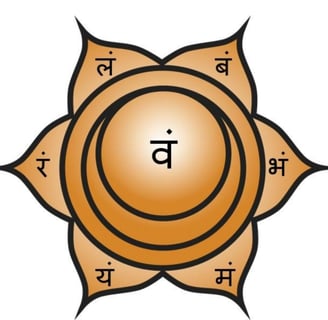Awakening the Sacral - Swadhisthana Chakra
The coordination of various activities is vital for helping kundalini rise through the central canal of the sushumna, which is essentially the spinal cord. Now, let's delve into another exercise aimed at guiding the kundalini energy upward from the lower chakras. As you inhale, draw your shoulders back and lift them while envisioning prana flowing into the sushumna. Picture your breath moving in and out through this vital channel.


The coordination of various activities is crucial for facilitating the ascent of kundalini through the central canal of the Sushumna, or spinal cord. We will now explore another exercise designed to elevate the kundalini from the lower chakras. As you inhale, retract your shoulders and lift them while visualizing prana flowing into the Sushumna. Essentially, you should imagine that your breath is moving in and out through the Sushumna. This visualization is intended to help you focus on the kundalini and its pathway. Your shoulders should move in a specific manner. During inhalation, engage moolabandha, allow your abdomen to expand, raise your shoulders as described, and concentrate your mind on the chakra along with its corresponding color. All these elements must be synchronized as you guide the kundalini from one chakra to the next. You might find it challenging to visualize the transition of colors between chakras, but it is manageable. For instance, as you shift your kundalini from the muladhara chakra to the Swadhisthana chakra, the deep red of the Muladhara will gradually transform into orange and then further into yellow at the navel chakra. With consistent practice, the concept of color will fade, allowing you to move your kundalini seamlessly from one chakra to another. However, it is not sufficient to merely shift the kundalini; activating each of the six chakras is essential. We will delve deeper into chakra activation later. Properly activating the chakras may grant you certain extraordinary abilities, although this may not occur for many due to insufficient practice. When chakras are activated, you can sense energy emanating from both the front and back sides of the chakra. In the previous series, we learned how to penetrate the Brahma granthi. Once the kundalini breaks through the Brahma granthi, it can easily ascend to the swadhisthana chakra. The energy then transitions from the swadishtan chakra to the naval chakra, also known as the Manipura chakra. Let's delve into the swadishtan chakra, which is located just above the coccyx.
This chakra is linked to the color orange, so it's essential to meditate on it while visualizing this hue. When activated, you may experience a sensation of pressure in the area above the coccyx. The swadishtan chakra is connected to the element of water, symbolizing a stage where you can contemplate liberation, as it relates to the mind. This phase differs from your experience with the Muladhara chakra. In the base chakra, your focus is entirely on worldly attachments and activities. While swadishtan still involves some attachment to the material world, there is a shift towards a consideration of the divine. Unlike in the Muladhara chakra, where spiritual growth is often overlooked, here you have the opportunity to reflect on your spiritual path. This change in perspective arises from your desire to recognize the detrimental effects of ego. Water, known for its purifying properties, plays a significant role in this chakra, facilitating your purification process. As this chakra becomes fully activated, your sexual desires may diminish. Additionally, swadishtan is still associated with tamo guna, given its proximity to the Muladhara chakra. Your consciousness begins to expand, marking the beginning of your spiritual journey from this point.
